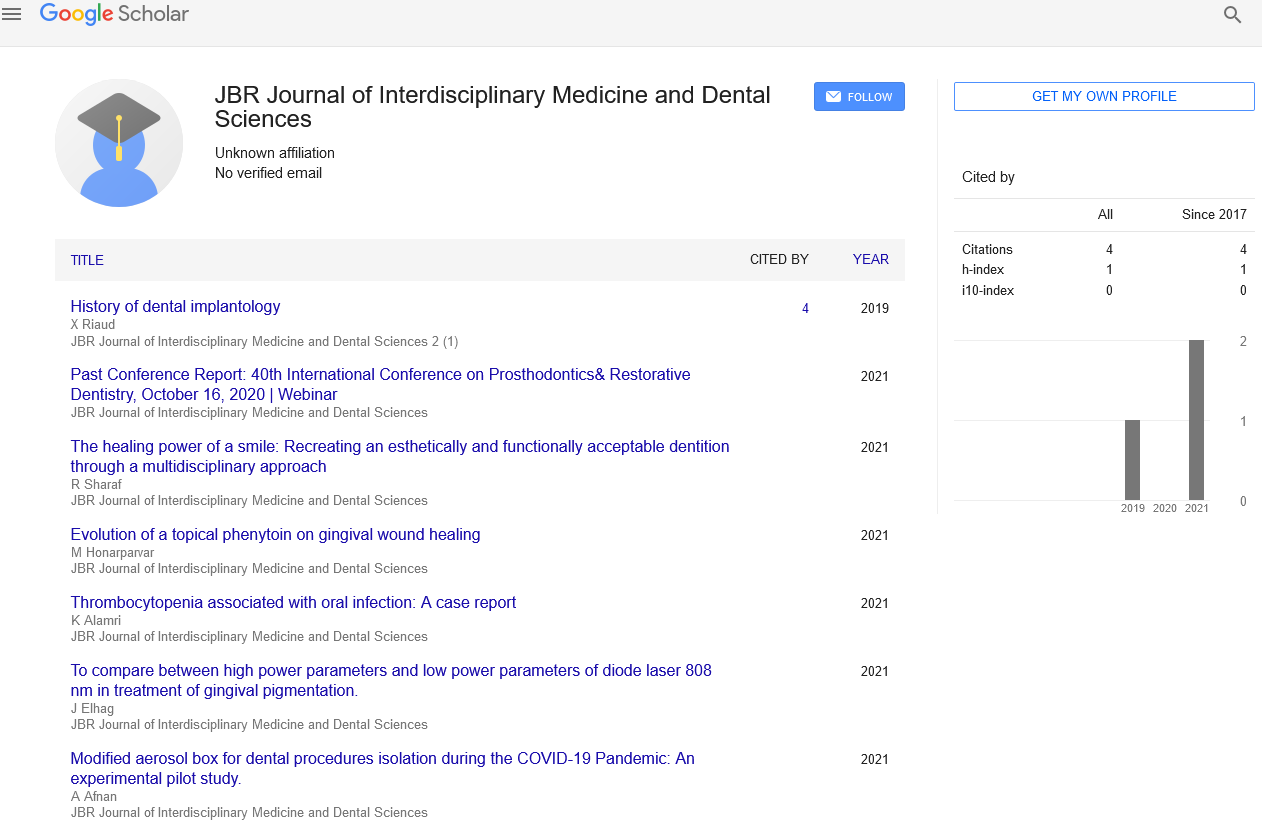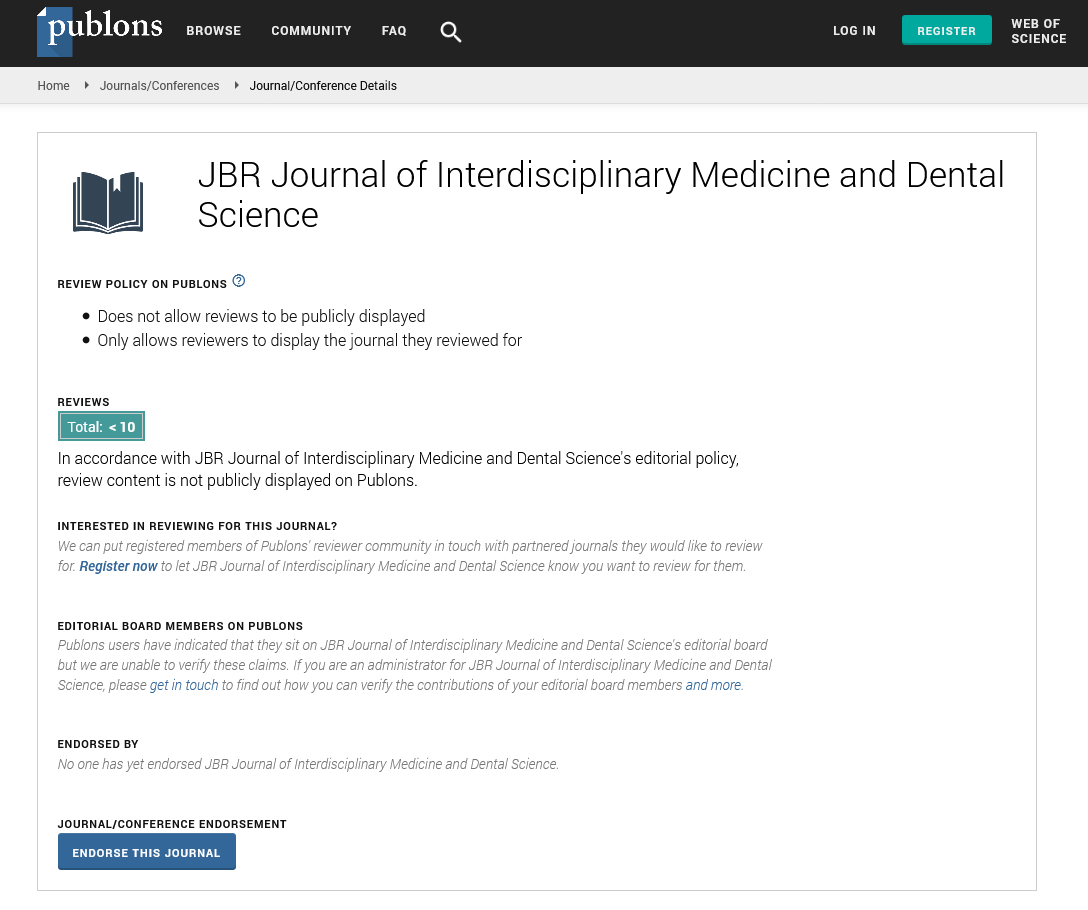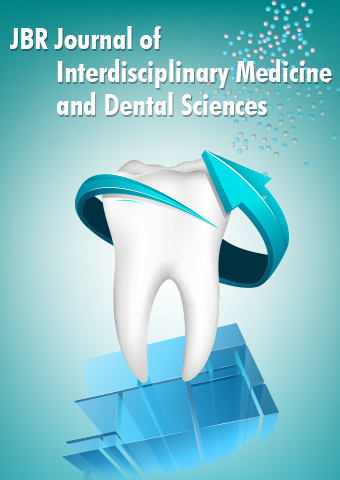Commentary - JBR Journal of Interdisciplinary Medicine and Dental Sciences (2022) Volume 5, Issue 4
Protection and Reinforcement of Tooth Structures
Toru Nikaido*
Cariology and Operative Dentistry, Department of Oral Health Sciences, Graduate School of Medical and Dental Sciences, Tokyo Medical and Dental University, 1-5-45 Yushima, Bunkyo-ku, Tokyo 113-8549, Japan.
Cariology and Operative Dentistry, Department of Oral Health Sciences, Graduate School of Medical and Dental Sciences, Tokyo Medical and Dental University, 1-5-45 Yushima, Bunkyo-ku, Tokyo 113-8549, Japan.
E-mail: alireza.ope@tmd.ac.jp
Received: 01-Jul-2022, Manuscript No. jimds-22-31007; Editor assigned: 04-Jul-2022, PreQC No. jimds-22-31007; Reviewed: 15- Jul-2022, QC No. jimds-22-31007; Revised: 22-Jul-2022, Manuscript No. jimds-22-31007 (R); Published: 29-Jul-2022 , DOI: 10.37532/2376- 032X.2022.5(4).64-65
Abstract
The resin coating is applied on the cut surfaces immediately after tooth preparation and before making an impression by assembling a dentin bonding system and a flow able composite. Resin coatings minimize pulp irritation and improve the bond strength between a resin cement and tooth when bonding the restoration to tooth. Recently, thinfilm coating dental materials based on all-in-one adhesive technology were introduced for resin coating of indirect restorations. In light of the many benefits provided by such a protective layer, these all-in-one adhesive materials may therefore also have the potential to cover exposed root dentin surfaces and prevent caries formation. In this paper, recent progress of the dental coating materials and their clinical applications are reviewed. The thin coatings play an important role in protecting the dentin from physical, chemical, and biological irritation.
Keywords
minimal intervention • adhesive dentistry • resin coating • technique super dentin
Introduction
Dentin is the calcified product of the odontoblasts which line the inner surface of the dentin within the periphery of the external pulp tissue [1]. Therefore, the dentin and pulp are morphologically and embryologically a single unit. Dental caries (tooth decay) is a multi-factorial disease associated with a cariogenic diet and microbiological invasion of the teeth that result in localized dissolution and destruction of the calcified tissues. It is essential to understand that cavitation’s in teeth (destruction of the tooth surface, creating a cavity) are signs of dominant loss of mineral from tooth as a result of bacterial acid production. Conventionally, intact and sound dental tissues were removed to establish the mechanical retention form of the cavity to avoid failure of the restoration, which were performed by materials without a strong adhesion to the tooth. Nowadays, the concept of minimal cavity preparation which requires only the infected parts to be removed has become widely accepted for the placement of direct composite restorations by using an adhesive e system [2]. The ABRZ should be ascribed to an effective diffusion of the acidic monomer of the self-etching system beyond the hybrid layer, and their chemical bonding potential with apatite as the substrate. Based on the attributes of this zone, which was more resistant against acidic and basic attack compared to the underlying normal dentin, the reinforced dentin was proposed to be called as “Super Dentin”. Indirect restorations are still among the main options when the prepared cavity is extensive. However, conventional inlay/onlay restorations have some inherent drawbacks [3]. When a cavity is prepared for an indirect inlay/onlay restoration, intact tooth structure has to be sacrificed to obtain the retention and resistance forms, especially because the conventional luting cements have a poor capability of bonding to tooth structure.
Description
According to the Black’s principles, sacrifice of the dental tissue is required to establish mechanical retention and resistance of restoration; however, in the new concept of adhesion, only the infected caries should be removed, thus preserving the caries-affected dentin and intact dentin even when teeth have extensive caries. When the lost tooth structure is to be replaced by an indirect restoration, the exposed enamel and dentin should be immediately sealed using the resin coating technique. This rational approach to adhesion has a positive influence on tooth structure preservation, patient comfort, and the long-term survival of indirect bonded restorations. In addition, the incompletely polymerized resin coating can inhibit the polymerization reaction of impression materials, which depends on selection of the materials [4]. The contamination of the resin coating by the temporary filling material also remains an issue, as it may alter the bond between the existing resin coating and the luting agent. the two different application methods for the resin coating, such as a combination of a dentin bonding system and a flow able resin composite, and a thin film coating material. The combination method demonstrates more reliable dentin bonding performance than the thin film coating. The superficial penetration and surface coating of the adhesive and/or caries infiltrate is considered as a treatment option for protecting enamel dissolution. From the clinical stand point, to control the biofilm adherence on the coating material is also important to reduce caries risk in the oral environment [5]. A series of experimental coating materials with self-cleaning surface property have been developed, which demonstrated such surface property had good potential to inhibit biofilm adherence. If such materials with a surface property could be combined with the current adhesive technology, the surface coating will become a promising therapy in preventive dentistry in the future.
Acknowledgement
None
Conflict of Interest
No conflict of interest
References
- Inokoshi S. Temporary sealing-pulp and dentin protection using low viscosity composite. Adhes Dent. 10, 250(1992).
- Sato M , Goto H , Inai N et al. How to use “Liner Bond System” as a dentin and pulp protector in indirect restorations . Adhes. Dent.12, 41–48(1994).
- Otsuki M , Yamada T, Inokoshi S et al. Establishment of a composite resin inlay technique part 7. Use of low viscous resin . Jpn. J. Conserv. Dent.36, 1324–1330(1993).
- Jayasooriya PR, Pereira PNR, Nikaido T et al. Effect of a “Resin-coating” on the interfacial adaptation of composite inlays. Oper. Dent.28, 28–35(2003).
- Kosaka S, Kajihara H, Kurashige H et al. Effect of resin coating as a means of preventing marginal leakage beneath full cast crowns. Dent. Mater. J. 24, 117–122(2005).


